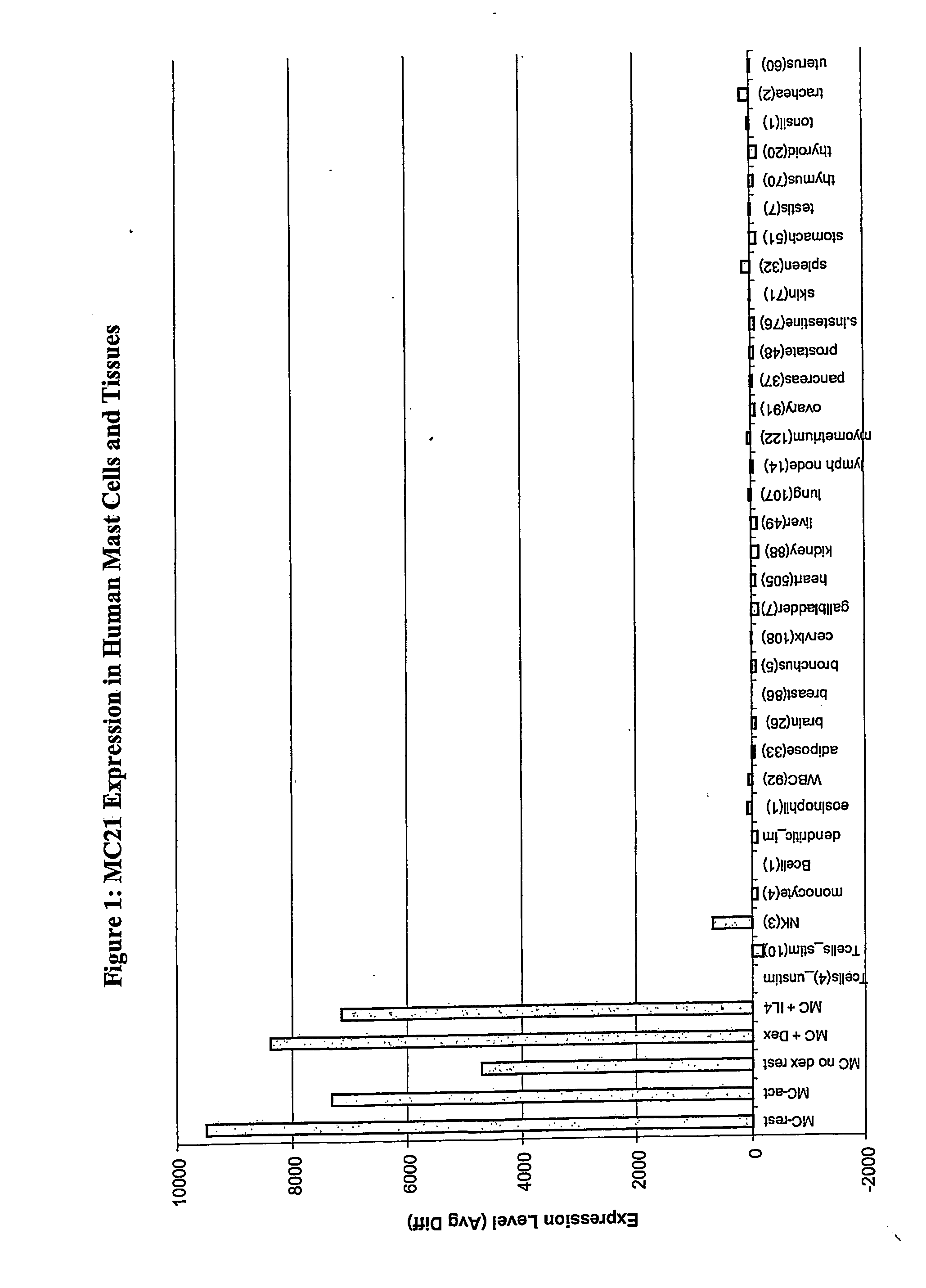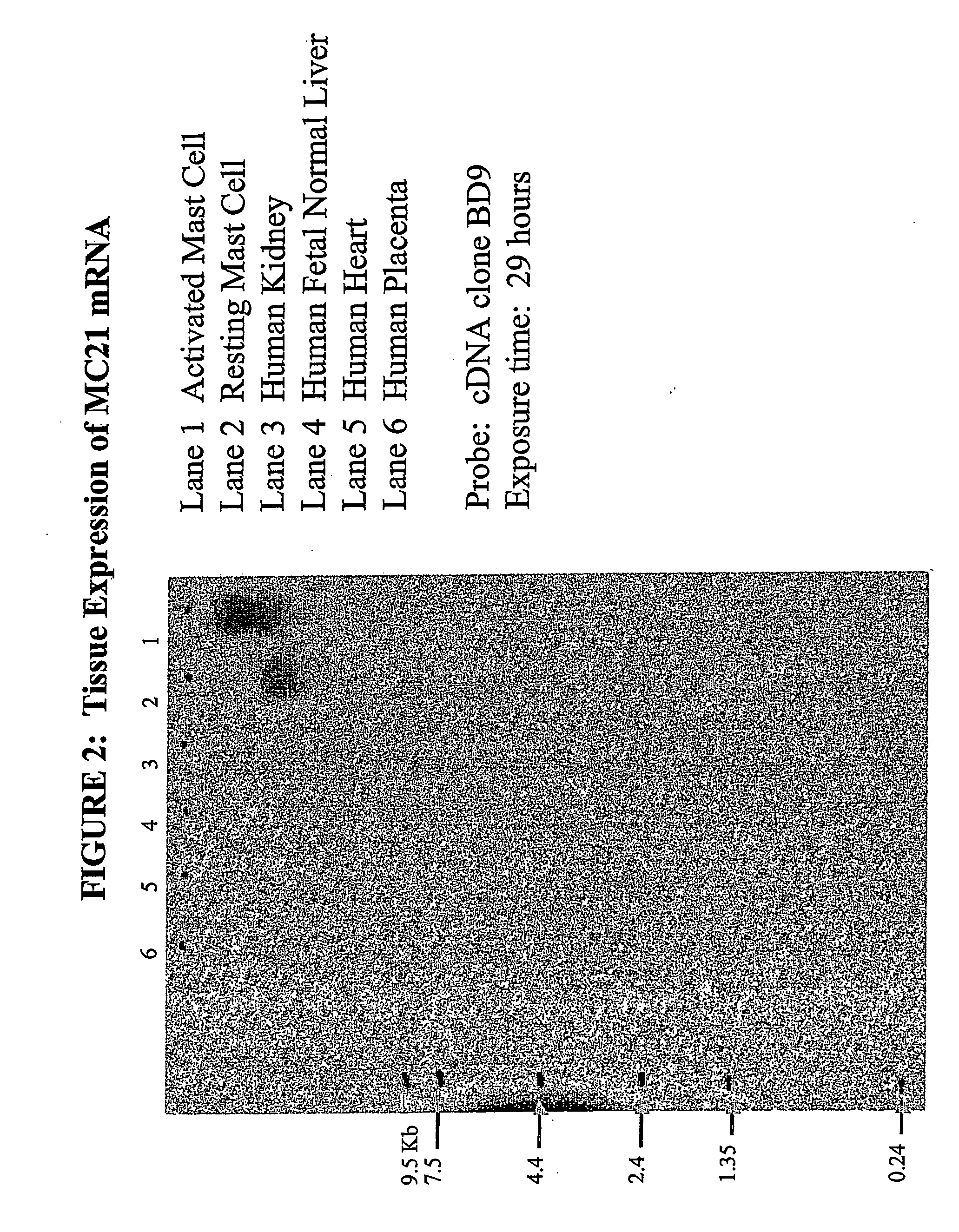Genes associated with mast cell activation
a mast cell activation and gene technology, applied in the field of gene expression changes, can solve the problems of life-threatening anaphylactic reactions, food allergies, and anaphylactic reactions which can be fatal, and achieve the effect of reducing the risk of anaphylactic shock and death
- Summary
- Abstract
- Description
- Claims
- Application Information
AI Technical Summary
Benefits of technology
Problems solved by technology
Method used
Image
Examples
example 1
Identification of the Differentially Expressed MC21 mRNA in Mast Cells
[0132] To identify genes which are differentially expressed or regulated in mast cells, mRNA was isolated from cultured human mast cells, isolated hematopoietic cells, and normal human tissues and used in an electronic Northern assay to probe a series of target sequences from the human genome. The intensity of expression of AF150143 (MC21; SEQ ID NO: 1) was measured across a panel of tissues and cell cultures using the Affymetrix human GeneChip 95K chip set. The mean intensity of expression is shown in FIG. 1. The number of data points included in each mean value is given in parentheses to the right of the tissue name. Mast cell samples were cultured for 6 weeks and then harvested or treated as specified. Rest=untreated. Act=3 hours after activation by IgE and antigen. Dex=24 hours after treatement by 10−7 M dexamethasone. El-4=5 days after treatment with 10 ng / ml IL-4. T cells stim=stimulation by antibodies to ...
example 2
Cloning of a Full Length Human cDNA Corresponding to the Differentially Expressed mRNA Species
[0133] The full-length cDNA having SEQ ID NO: 1 was obtained by the solution hybridization method. Briefly, a gene-specific oligo was designed based on the sequence of the EST fragment identified in Example 1. The oligo was labeled with biotin and used to hybridize with 5 μg of single strand plasmid DNA (cDNA recombinants) from a human resting mast cell library following the procedures from the GeneTrapper® kit obtained from Invitrogen. The hybridized cDNAs were separated by streptavidin-conjugated beads and eluted by TE buffer. The eluted cDNA was converted to double strand plasmid DNA and used to transform E. coli cells (DHα5).
[0134] The nucleotide sequences of the full-length human cDNA corresponding to the differentially regulated mRNAs detected above is set forth in SEQ ID NO: 1. The cDNA comprises 1596 base pairs, with a open reading frame at nucleotides 70-1038 (nucleotides 70-104...
example 3
Detection of Allergic Hypersensitivity in a Patient
[0135] The expression level of a nucleic acid or protein of the invention is determined in a sample from a patient suspected of allergic hypersensitivity before and / or after exposure to a potential antigen. The sample may be from an epithelial tissue such as a skin, respiratory tract or lung cell samples, or in urine or in blood samples. The sample may also be bronchoalveloar wash. Tissue or isolated mast cell samples from a patient known to have allergic hypersensitivity and from normal subjects may be used as positive and negative controls, respectively. A change in the level of expression of the nucleic acid or protein of the invention compared to the expression level in control or normal tissue may be indicative of allergic hypersensitivity.
PUM
| Property | Measurement | Unit |
|---|---|---|
| pH | aaaaa | aaaaa |
| pH | aaaaa | aaaaa |
| temperature | aaaaa | aaaaa |
Abstract
Description
Claims
Application Information
 Login to View More
Login to View More - R&D
- Intellectual Property
- Life Sciences
- Materials
- Tech Scout
- Unparalleled Data Quality
- Higher Quality Content
- 60% Fewer Hallucinations
Browse by: Latest US Patents, China's latest patents, Technical Efficacy Thesaurus, Application Domain, Technology Topic, Popular Technical Reports.
© 2025 PatSnap. All rights reserved.Legal|Privacy policy|Modern Slavery Act Transparency Statement|Sitemap|About US| Contact US: help@patsnap.com



